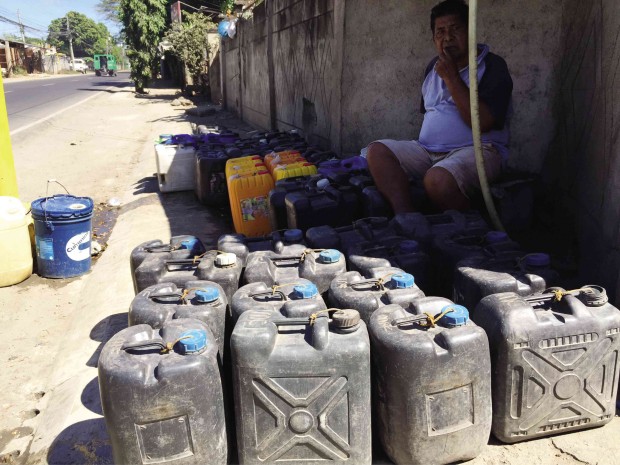
CONTAINERS are waiting to be filled with water in a village faucet in Zamboanga City, which is suffering from drought as a result of the El Niño phenomenon. JULIE ALIPALA/INQUIRER MINDANAO
Cobras slithering into villages in Kidapawan City. Eggplants turning from purple, foot-long vegetables to burnt brown, 2-inch inedible clumps.
The effects of the dry spell brought by the El Niño phenomenon are wide ranging in Mindanao provinces, towns and villages where the absence of rain is changing the landscape and the way of life of hundreds of communities.
But while the face of El Niño’s devastation may be different from place to place, it is painting just one scenario—devastation.
In Kidapawan, a 62-year-old man was just resting in his shanty when he was bitten by a king cobra in the village of Sumbac, a rubber plantation community.
According to Psalmer Bernalte, head of the Kidapawan Disaster Risk Reduction and Management Council, the man, Bonifacio Digao, was bitten by an 2.44-meter long cobra, locally known as “banakon.”
Digao is now comatose in an undisclosed hospital.
The snake was killed by Digao’s neighbors, but city officials said residents of the village should be watchful for more snakes being driven out of their habitats by extreme heat associated with El Niño.
The snakes, said Mayor Joseph Evangelista, are in search of cooler places and the “temperature is always colder in rubber plantation areas.”
In the town of Tagaloan, Misamis Oriental province, the effects of drought that are staring farmer Rolly Tacud in the face may not be as scary as a cobra’s fangs but are as deadly.
Tacud, 50, could only stare in disbelief at his half-hectare vegetable plot, which has become his source of income for the last two years after giving up a job as a motorcycle salesman.
Just last year, Tacud had high hopes that vegetable farming was a worthy income alternative to selling motorcycles after he earned thousands of pesos selling his produce.
When rain was abundant last year, Tacud said, he earned an average of P3,000 a day on eggplants alone.
But when the rains stopped coming in late December, Tacud’s fate became as clear as the cloudless sky above his farm—uncertain.
He could now barely repay debts that he incurred to buy seeds and fertilizers.
In Claveria, another Misamis Oriental town, farmer Numeriana Nacario, 74, is preparing to accept the inevitable: heavy losses in her and her husband’s 2-ha farm planted to corn, bananas and root crops.
Nacario said she had expected to harvest corn this month, “but the young cobs have already withered and died.”
Tacud’s and Nacario’s farms are both dependent on the rain and are not covered by irrigation systems.
Tacud said that while he had a well, it had become too expensive for him to use his pump to draw water from it. “I could no longer afford to pay for the electric bills for my pump,” said Tacud.
Tacud and Nacario are just some of the small-scale farmers who are getting hurt by El Niño. Both said they had yet to get financial or material aid from their local governments.
Concepcion Salcedo, Misamis Oriental agriculturist, said the provincial government had allotted P11 million this year to help farmers cope with El Niño.
She said hundreds of bags of heat-resistant, open-pollinated variety (OPV) rice and white corn seedlings were now ready for distribution and more were to be purchased from suppliers in Valencia City and Kabacan, North Cotabato province.
The provincial agriculture office is also preparing vegetable seeds for distribution.
Salcedo said her office is closely watching the towns of Laguindingan, Alubijid, Opol, Initao, Gitagum, parts of Claveria and Tagoloan and El Salvador City, which could be areas worst hit by the drought.
She said the province had received P9.7 million worth of irrigation pumps to be used to ease the effects of the dry spell.
According to the Department of Agriculture (DA) in Northern Mindanao, the total loss in agricultural production in the region has already reached P792 million. At least 11,709 farmers are suffering from income loss as of Feb. 17.
Bukidnon province, according to the DA, is the worst hit province in the region. Williamor Magbanua, with a report from Jigger Jerusalem, Inquirer Mindanao